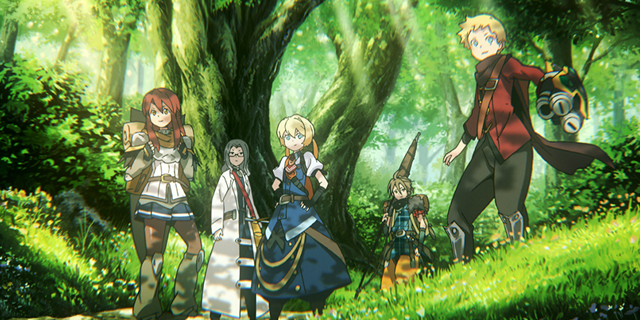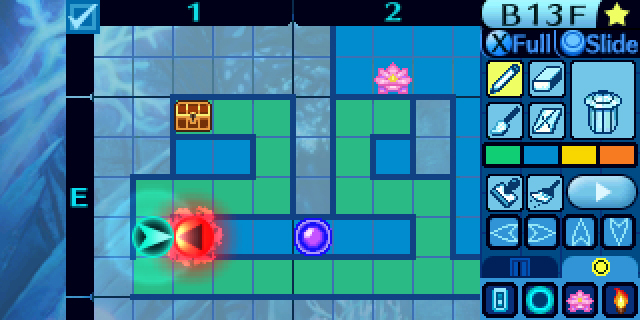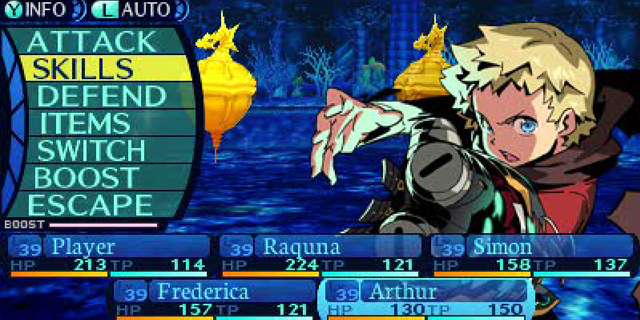
Etrian Odyssey has always been about player agency, allowing you full control over every aspect of your party, from their names and appearance to their class and equipment. Likewise, the central story tends to serve as a backdrop for your characters to explore the multi-floor labyrinth that you’ll spend most of your time in. Etrian Odyssey Untold: The Millennium Girl casts that aside for its main mode, layering the existing story from Etrian Odyssey with a cast of pre-built characters and expanding on the story itself.
Etrian Odyssey Untold is a remake of the first game in the series, and features many of the updated mechanics from the intervening games. There are two ways to play. You can play the original version, complete with all the new mechanics. The focus is on the new story mode, though. You play as a Highlander, sent to Etria at the request of its rulers, the Radha, to investigate the tremors that have been shaking the town and its labyrinth. This investigation takes you to the ruins of an ancient civilization, where you chance upon a team of researchers from an Academy who are also looking into the quakes in the region. Working together, you find and awaken a girl in suspended animation in the ruins, who joins you, on the promise your new team will help her discover her past along the way.

The most distinctive aspect of the Etrian Odyssey series is the lack of maps when descending through the dungeons. Instead, you are given the tools to create your own map as you explore, complete with icons for resource gathering places, treasure chests, shortcuts and more. This isn’t just a mechanic that helps you find your way through the floor when you’re exploring, though; many of the quests and missions you can accept throughout the game will force you to rely on the maps you’ve drawn, and if they are inaccurate, you’re just making things more difficult on yourself. Additionally, a largely-complete map with entrance and exit points will enable fast travel to and from that floor, reducing unnecessary backtracking. Charting your progress as you go is addictive, and I often found myself playing long after I planned to stop whenever I reached a new floor.
Most battles in Etrian Odyssey Untold are random encounters that become more likely the more steps you take, though there are also very powerful enemies that will show up in the dungeons called FOEs. These enemies are extremely strong and often take a lot of work to beat, if at all, when you first encounter them, so it’s often best to avoid them early on. Everything is turn-based, including your movements, so FOEs will only move when you do. Within the battles, success will depend not just on doing lots of damage, but on binding the head, arms or legs of enemies, depending on what types of attacks they do. There are many enemies with devastating attacks can that hit multiple party members and often a well-timed binding will be the difference between victory and death. There’s a good bit of strategy involved in fights, and a well-balanced party can often defeat vastly more powerful foes if the right skills are chosen. Similarly, bad strategy can turn an even fight into a slaughter.

Party members can be any of nine classes, from the landsknecht, a physical melee attacker, to the hexer, a dark magic user who curses the enemy. Each class has a skill tree that enables you to pick and choose just how a character progresses. If you want your medic to focus on disabling enemies, you can. Prefer spears to swords for your landsknecht? Put points into the spear skills instead. Thankfully, you’re never locked into any skill choices you make. By visiting the guild hall in town, you can re-spec anyone you want at the cost of two levels of experience.
Equipment is bought from the item shop, and aside from a few basic types, is entirely dependent on what kinds of loot you bring back from exploring and sell there. Most items are permanent once their item requirements are met, but some, such as revival items and some special weapons, require new more resources for each item you buy.
The character and enemy portraits are very detailed, and the art style looks great on the 3DS, though the environments of the various dungeons you’ll explore aren’t very impressive or varied. Most floors will have just a few patterns that make up the environment, tiled one after the next. On one hand, this makes secrets such as shortcuts easier to spot, but it also makes the dungeon rather boring to look at, after the first few minutes of a new environmental stratum.
The music and voice acting are fairly basic, but they get the job done. None of the music is especially memorable or varied, but despite the amount of time you’ll hear the same thing in the dungeons, it doesn’t get grating.
The Millennium Girl’s focus on putting established characters into the Etrian Odyssey storyline is an interesting decision, but it works fairly well, especially as an introduction to the series. The fact that Classic mode is an option means that everyone, even purists, should be able to enjoy mapping their way through Etria again.
Pros: Mapping dungeons is addictive, combat is strategic, story is a great addition
Cons: Environments blend together quickly



















